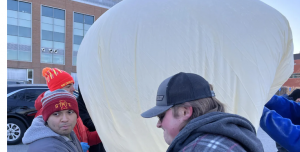IA eclipse research balloon pops, sends ‘cool’ data back to Earth
April 29th, 2024 by Ric Hanson
(Iowa News Service) – Environmental scientists in Iowa are starting to analyze data they collected with a research balloon during the recent solar eclipse. The mission was part “cool factor,” part high-tech research project. Matthew Nelson, director of the Make to Innovate program at Iowa State University, and a team of seven eclipse chasers trekked to launch their high-tech balloon in Carbondale, Illinois, the only place in the country in the path of the total solar eclipse both this year and in 2017. At an altitude of 95,000 feet, the craft studied the atmospheric effects of the eclipse, but Nelson said there were also less scientific reasons at play.
“One, there’s the cool factor,” Nelson explained. “It’s really kind of an interesting effect and it looks spectacular. I mean, you can see the whole round shadow as it moves across the ground. It’s very much like seeing the eclipse itself. It’s kind of one of those surreal types of things.” Beyond recording video of the shadows, the balloon collected highly technical atmospheric and solar data, which Nelson is starting to study. Video from the balloon, and its flight path, are online.

Iowa State University students inflate a high-altitude balloon and prepare for launch in the Howe Hall parking lot on March 23. The launch will prepare them for a similar experiment during the upcoming solar eclipse. Photo by Fred Love. (ISU Photo)
Nelson noted the balloon was monitoring atmospheric pressure, humidity levels, temperature and solar radiation during the eclipse, things they do not typically have the chance to study. “We can measure some of the solar flares, and stuff like that, when the bulk of the sun is blocked out like that,” Nelson stressed. “It’s a unique opportunity to see what can we learn from these eclipses.”
Once the balloon had done its job and was beginning to return to Earth, it detached from the high-tech gear, ascended well beyond its “cruising altitude” and popped. Nelson was able to collect the gear, which landed safely, thanks to a parachute.





